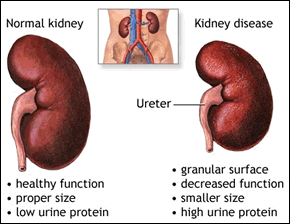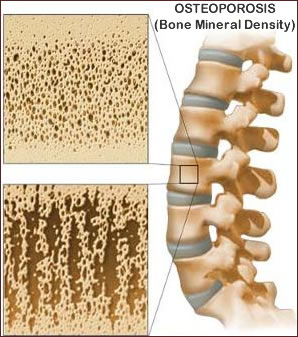Low
Bone Mineral Density, Fracture Risk, and Kidney Dysfunction in HIV
Positive Men
 |
 |
 |
 |
 |
 |
 |
| SUMMARY:
In a study that included mostly HIV positive men, 42%
were found to have low bone mineral density (BMD) and
7% had evidence of kidney dysfunction, researchers reported
in the December
1, 2009 Journal of Infectious Diseases. Use
of tenofovir
(Viread, also in the Truvada
and Atripla
combination pills) was linked to kidney impairment and
increased bone turnover, but not to low BMD. |
|
 |
 |
 |
 |
 |
 |
 |
By
Liz Highleyman
 Several
studies have assessed bone loss in people with HIV, but results
have not been consistent. Most have shown that HIV
positive people overall have decreased BMD, but it is still
not clear whether this is attributable to HIV infection itself,
antiretroviral therapy
(ART), or both. Likewise, the role of proximal renal tubular
dysfunction (PRTD) -- a type of kidney impairment -- and alterations
in bone metabolism in this population are not fully understood.
Several
studies have assessed bone loss in people with HIV, but results
have not been consistent. Most have shown that HIV
positive people overall have decreased BMD, but it is still
not clear whether this is attributable to HIV infection itself,
antiretroviral therapy
(ART), or both. Likewise, the role of proximal renal tubular
dysfunction (PRTD) -- a type of kidney impairment -- and alterations
in bone metabolism in this population are not fully understood.
 Alexandra
Calmy from St. Vincent's Hospital in Sydney, Australia, and colleagues
measured BMD using dual-energy x-ray absorptiometry (DEXA), blood
and urine markers of bone metabolism and kidney function, and
risk factors for low BMD (hip or spine T score <-1).
They then analyzed factors associated with low BMD and calculated
10-year fracture risk using the World Health Organization's FRAX
equation.
Alexandra
Calmy from St. Vincent's Hospital in Sydney, Australia, and colleagues
measured BMD using dual-energy x-ray absorptiometry (DEXA), blood
and urine markers of bone metabolism and kidney function, and
risk factors for low BMD (hip or spine T score <-1).
They then analyzed factors associated with low BMD and calculated
10-year fracture risk using the World Health Organization's FRAX
equation.
The
study included 153 adults in an ambulatory care setting. Almost
all (98%) were men, the median age was 48 years, and the median
body mass index was 24.5. Overall, participants had well controlled
HIV disease, with a median CD4 count > 500 cells/mm3 and 83%
having undetectable HIV RNA. With regard to ART, 44% were taking
tenofovir and 53% were using boosted
protease inhibitor-based regimens.
Results
 |
42%
of study participants had low BMD, 16% had bone loss extensive
enough to require bisphosphonate treatment, and 4% had osteoporosis
(severe bone mineral depletion). |
 |
7%
of patients had proximal renal tubular dysfunction. |
 |
Kidney
dysfunction was significantly associated with longer duration
of HIV infection, longer exposure to tenofovir, use of boosted
protease inhibitors, and lower body mass index. |
 |
In
a multivariate analysis controlling for other factors, low
BMD was linked to use of boosted protease inhibitors (odds
ratio 2.69), while higher testosterone level was protective
against bone loss. |
 |
Use
of tenofovir did not predict decreased BMD, but it was significantly
associated with increased markers of osteoblast and osteoclast
activity, indicating bone turnover (the process of absorption
and rebuilding of bones). |
 |
Mean
estimated 10-year risks were 1.2% for hip fractures and 5.4%
for any major fracture due to osteoporosis. |
Based on these findings, the study authors concluded, "In
this mostly male population, low BMD was significantly associated
with protease inhibitor therapy."
"Tenofovir recipients showed evidence of increased bone turnover,"
they continued. "Measurement of BMD and estimation of fracture
risk may be warranted in treated HIV-infected adults."
Given that participants mostly had well controlled HIV disease,
undetectable viral load, and high CD4 cell counts, they suggested,
"it is difficult to conclude that HIV replication and disease
severity are important contributors to the observed low bone mineral
density in our population."
HIV,
Immunology and Infectious Diseases Unit and Centre for Applied
Medical Research, St Vincent's Hospital, Garvan Institute for
Medical Research, and National Centre in HIV Epidemiology and
Clinical Research, University of New South Wales, Sydney, Australia;
HIV Unit, Geneva University Hospital, Geneva, and University Clinic
for Infectious Diseases and University of Berne, Switzerland.
2/2/10
Reference
A
Calmy, CA Fux, R Norris, and others. Low bone mineral density,
renal dysfunction, and fracture risk in HIV infection: a cross-sectional
study. Journal of Infectious Diseases 200(11): 1746-1754 (Abstract).
December 1, 2009.
